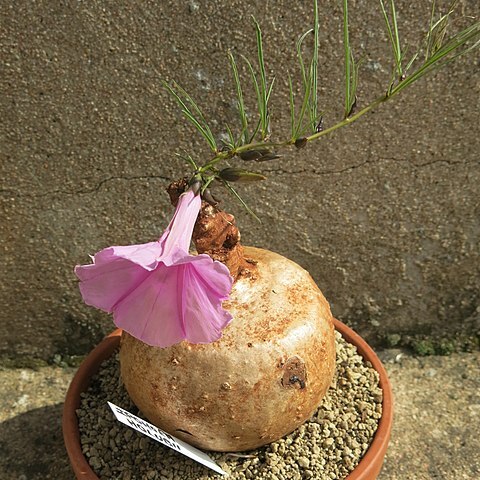Much-branched shrub up to 2.5 m high. Stems woody, many from base, covered with a light grey bark, sinuous, tips decumbent or climbing. Leaves deciduous, ovate-cordate to orbicular-cordate, 10-80 x 7.5-50.0 mm, entire, often folded along midrib, apex obtuse or subacute, deflexed, base mostly widely cordate, sericeous to tomentose on both surfaces, more densely so beneath; petiole pubescent, 4-25 mm long. Inflorescence axillary, 1-5-flowered, sometimes forming a kind of leafy panicle at tips of branches; peduncle 25-90 mm long, hairy; pedicels 8-30 mm long, hairy; bracteoles hairy, 2.5-15.0 mm long, often numerous and forming a kind of involucre at base of cyme and then one bracteole foliaceous and up to 40 x 20 mm. Calyx 6-16 mm long, usually greyish pubescent to tomentose, unequal, elliptic to obovate-spathulate, outer sepals smaller than inner ones, all accrescent in fruit, then glabrescent and brown. Corolla funnel-shaped, 40-50 mm long, pale mauve or pinkish with magenta centre, limb spreading horizontally up to ±60 mm wide; midpetaline areas strigose outside. Capsule with thin leathery pericarp, ellipsoid, apiculate, 8-10 mm long. Seed single, ellipsoid, ±7 mm long, glabrous, light brown.
More
Erect, decumbent or climbing shrub, up to 2.5 m high. Leaf lamina ovate-cordate to circular-cordate, entire, Often folded along midrib, sericeous to tomentose on both surfaces. Sepals elliptic to obovate or orbicular to obovate-spathulate, obtuse and mucronate or apiculate, greyish pubescent to tomentose. Corolla funnel-shaped, up to 75 mm long. Flowers pale mauve or pinkish with magenta centre.

